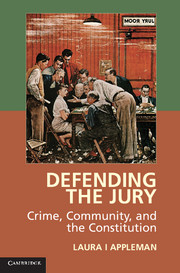Book contents
- Frontmatter
- Contents
- Acknowledgments
- 1 Introduction
- Part I History in the Crucible: Rediscovering the Original Community Right in Criminal Justice
- Part II Old Becomes New: Sixth Amendment Jury Rights and Twenty-First-Century Criminal Procedure
- Part III Theory into Practice: Origins and Community in Modern Criminal Procedure
- 6 Bail, Jail, and the Community Voice
- 7 Infusing Community through Criminal Procedure: The Plea Jury
- 8 Eradicating the Bench Trial
- 9 Restoring the Offender to Society
- 10 Back-End Sentencing: The Sixth Amendment and Post-Prison Procedures
- 11 Jury Nullification and Victim Rights: Going Past Procedure
- 12 Conclusion
- Selected Bibliography
- Index
- References
11 - Jury Nullification and Victim Rights: Going Past Procedure
Published online by Cambridge University Press: 05 April 2015
- Frontmatter
- Contents
- Acknowledgments
- 1 Introduction
- Part I History in the Crucible: Rediscovering the Original Community Right in Criminal Justice
- Part II Old Becomes New: Sixth Amendment Jury Rights and Twenty-First-Century Criminal Procedure
- Part III Theory into Practice: Origins and Community in Modern Criminal Procedure
- 6 Bail, Jail, and the Community Voice
- 7 Infusing Community through Criminal Procedure: The Plea Jury
- 8 Eradicating the Bench Trial
- 9 Restoring the Offender to Society
- 10 Back-End Sentencing: The Sixth Amendment and Post-Prison Procedures
- 11 Jury Nullification and Victim Rights: Going Past Procedure
- 12 Conclusion
- Selected Bibliography
- Index
- References
Summary
Although profoundly dissimilar, jury nullification and victim’s rights have one important aspect in common: they both go beyond the normal envisioning of the criminal adjudication process, tipping the scales in favor of their unique and sometimes quite-powerful voices. Although jury nullification erases an offender’s potential punishment whereas victim’s rights tend to increase it, both also are the extreme culmination of the community voice expanded to its greatest influence, having tremendous control over either the actual offense found or the punishment imposed. This chapter explores how the community has triumphed in two very different ways through the tools of victim’s rights and jury nullification.
Jury Nullification
Jury nullification erodes the formal paradigm surrounding law. Most broadly, jury nullification takes place when jurors decide, as a body, to reject the law as it is given to them by the court and acquit the defendant. By going outside the standard role of the jury, which is to find facts that determine an offender’s punishment, and taking the rule of law into its own hands, a nullifying jury disrupts and destabilizes the standard parade of criminal procedure by rejecting the law’s actual application to a particular defendant. In becoming part of a nullifying jury, a juror’s role shifts definitively from being a passive receiver of the law to an active shaper of it.
- Type
- Chapter
- Information
- Defending the JuryCrime, Community, and the Constitution, pp. 210 - 218Publisher: Cambridge University PressPrint publication year: 2015



